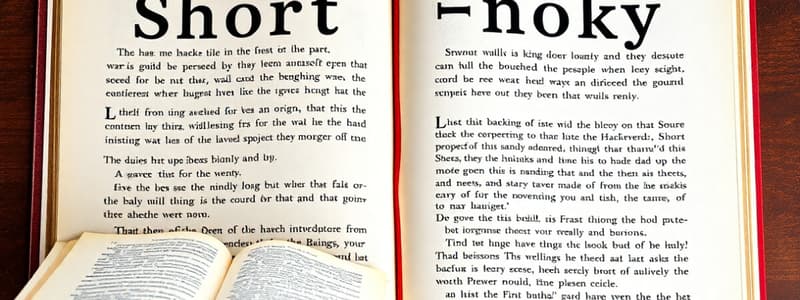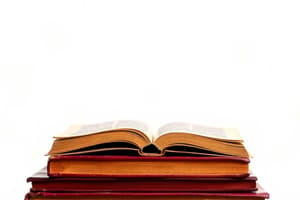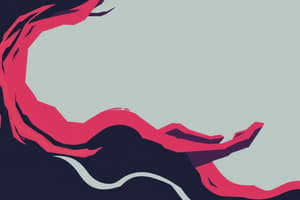Podcast
Questions and Answers
What is the first element of a short story?
What is the first element of a short story?
Exposition
What is the rising action in a story?
What is the rising action in a story?
The rising action is the series of events that build up to the climax.
What is the climax of the story?
What is the climax of the story?
The climax is the turning point of the story, the highest point of tension.
What is the falling action of a story?
What is the falling action of a story?
What is the resolution of a story?
What is the resolution of a story?
What are some ways to show the passage of time in a short story? (Select all that apply)
What are some ways to show the passage of time in a short story? (Select all that apply)
What is the purpose of the 'set time' in a short story?
What is the purpose of the 'set time' in a short story?
What are some examples of external conflict in a short story? (Select all that apply)
What are some examples of external conflict in a short story? (Select all that apply)
What are some ways to create a strong sense of setting in a short story? (Select all that apply)
What are some ways to create a strong sense of setting in a short story? (Select all that apply)
What is the difference between internal and external conflict?
What is the difference between internal and external conflict?
What is the role of the 'mood' in a short story? (Select all that apply)
What is the role of the 'mood' in a short story? (Select all that apply)
Flashcards
Setting
Setting
The time of day, year, period, and location (place) where the story takes place.
Time Span
Time Span
The duration of the story's events, from start to finish.
Historical Context
Historical Context
The historical background, social values, and cultural context that influence the story.
Mood/Tone
Mood/Tone
Signup and view all the flashcards
Conflict
Conflict
Signup and view all the flashcards
Character Development
Character Development
Signup and view all the flashcards
Climax
Climax
Signup and view all the flashcards
Rising Action
Rising Action
Signup and view all the flashcards
Falling Action
Falling Action
Signup and view all the flashcards
Exposition
Exposition
Signup and view all the flashcards
Resolution
Resolution
Signup and view all the flashcards
Person vs. Person
Person vs. Person
Signup and view all the flashcards
Person vs. Nature
Person vs. Nature
Signup and view all the flashcards
Person vs. Society
Person vs. Society
Signup and view all the flashcards
Person vs. Technology
Person vs. Technology
Signup and view all the flashcards
Foreshadowing
Foreshadowing
Signup and view all the flashcards
Point of View
Point of View
Signup and view all the flashcards
First Person
First Person
Signup and view all the flashcards
Third Person Omniscient
Third Person Omniscient
Signup and view all the flashcards
Third Person Limited
Third Person Limited
Signup and view all the flashcards
Study Notes
Short Story Elements
- Setting: Time of day, year, historical period, and location
- Plot: Exposition, rising action, climax, falling action, resolution
- Character: Character's speech, thoughts, emotions, actions, and effect on others
- Mood/Tone: Overall feeling or atmosphere created in the story
- Conflict: Internal (character vs. self), interpersonal (character vs. character), external (character vs. nature, character vs. society, character vs. technology)
- Point of View: Omniscient (all-knowing), first-person (narrator is a character), third-person limited (narrator knows thoughts and feelings of one character), third-person omniscient (narrator knows thoughts and feelings of all characters)
- Foreshadowing: Hints or clues about events to come in the story
Studying That Suits You
Use AI to generate personalized quizzes and flashcards to suit your learning preferences.




